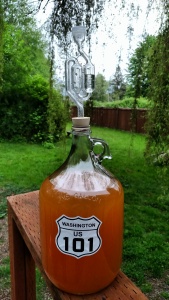The 101 Mead went into secondary today, about two weeks later than I’d planned. I didn’t want to leave it on the lees longer than 6 weeks, but life interfered. It was closer to 7-8 weeks. Holiday weekends are nuts at work.
The yeast in this batch, EC-1118, is tolerant and doesn’t tend to give off-flavors if you leave your must on the lees for longer than you wanted to. Here’s a great summary from Meadist, and you can read their summary of good mead yeasts here:
“This champagne yeast is a low foaming, vigorous and fast fermenter with a high alcohol and sulfate tolerance. Its a hearty yeast that can ferment in a broad range of temperatures and will inhibit wild yeasts. It’s a neutral yeast having little effect on the honey character. Make sure you give it significant time to age!
Alcohol Tolerance: 18%
Temperature: 45°-95°F”
On to racking and moving into secondary. This is the start of the fermentation period when oxygen is bad, and you absolutely don’t want to mix the must or leave a lot of headspace in your fermenting vessel. Take extra care while racking to minimize oxidation. I use a stool or any other piece of furniture to raise the carboy high enough that my siphon rests on the bottom of the carboy. That lets the mead flow from one vessel to the other with a minimum of turbulence. Also make sure that everything is sterilized before racking as well.
I get my siphon started, and then carefully move the mead from the plastic bucket into a 1 gallon glass carboy, where it’ll spend most of the next year. You’ll notice the yeast ‘cake’ on the bottom of your primary fermentation container, if you’re using a glass one. I guess at mine, but when I start seeing yeast being funneled into the siphon, I stop.
Then I put a cap and airlock on the secondary vessel. 101’s looks like this:
There’s a bunch of different caps and airlocks you can use. This one has a rubber bung, because the carboy is an old glass one I found at a thrift shop (for 3 bucks, no less!), and my standard screw-on caps didn’t fit. I then put it in my mead closet, which is dark and tends to stay at an even temperature. It sounds fancier than it is, really it’s the closet in the tiny second bedroom at my house. When I lived in Wyoming, the mead fermented on the floor of the pantry. You want a space that’s dark (light is not your mead’s friend, never ferment it in sunlight), and doesn’t yo-yo all over the damn place as far as temperatures go.
Now it sits. I took the specific gravity (SG) to keep track of it.
It tastes good. Boozy, which I expected with this yeast, but I can still pick up on the honey easily.
A note: I did wind up with extra must, which I didn’t add to the carboy because I wanted to avoid siphoning the yeast cake. The rest of the must went into a pint glass, and then into the fridge. Once it’s crashed and the yeast sinks to the bottom, I’ll add the rest of this to the carboy to bring it as close to the top as I can. I’ll leave 1-2″ for headspace, but really, you want as little space between the must and the airlock as possible at this point. Oxygen exposure in secondary is not good.
Now it’s time to be patient. I’ll rack it again in a few weeks, if I notice a lot of yeast falling out of the must, and take another SG then. But for now, it’ll happily stay in secondary anywhere from 6 months to a year. Next post will be on secondary and aging.
101 Mead Log:
OG (4/6/17): 1.12
EC-1118 yeast
3.5 lbs raspberry co-op honey
Water to 1 gallon
Fed on 4/7/17 (fermaid K)
SG going into secondary (6/1/17): 1.024

